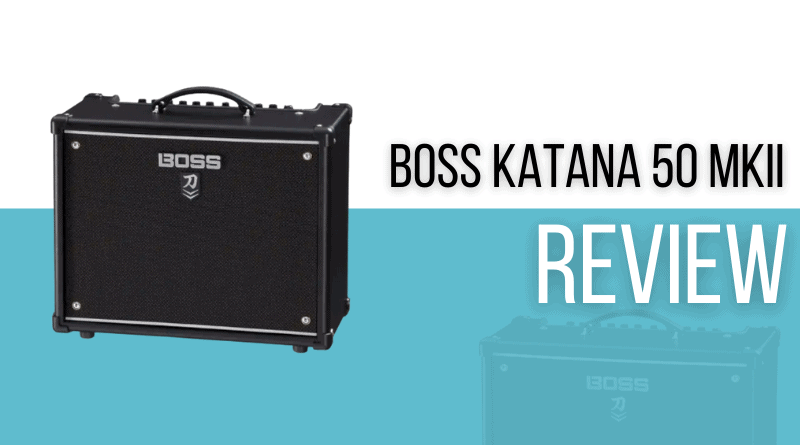There’s a reason that every thread asking for sub $500 amp recommendations is basically people chanting “Boss Katana.” First introduced in 2016, the Katana line not only sounded better than all of it’s competitors, it also offered a huge range of sounds thanks to not only having five different modes but also Boss’s entire pedal range built in.
2019 brought a second edition to the lineup, and Boss didn’t so much recreate the wheel as give it more options. Each of the five mode now has a “variation”, effectively giving you ten modes. In addition, you can now select up to five pedals instead of just three.
Those are just the headline changes, of course there’s a lot more going on under the hood – improved speakers, lighter amps, and improved prices.
We’re going to walk you through everything you need to know about the Boss Katana-50 MKII. Is it still the best budget amp on the market?
Spoiler alert: It is.
Read more about our review process.
Contents
Who is This For?
The Boss Katana is meant for every guitarist looking for great, stage-ready tone on a budget. The amp is popular with people who want to downsize their heavy tube rig, while still maintaining great sounds.
The Katana also sounds excellent at bedroom levels due to the ability to switch the wattage, so it has the added bonus of being great for home use – though, as we found out when we did our review of the best soundproof curtains, you can still annoy the neighbors with this amp.
Finally, the Katana outputs audio over USB, so it makes for a great amp for home recording, and sounds better than many of the most popular amp sims on the market.
Appearance / Features / Controls
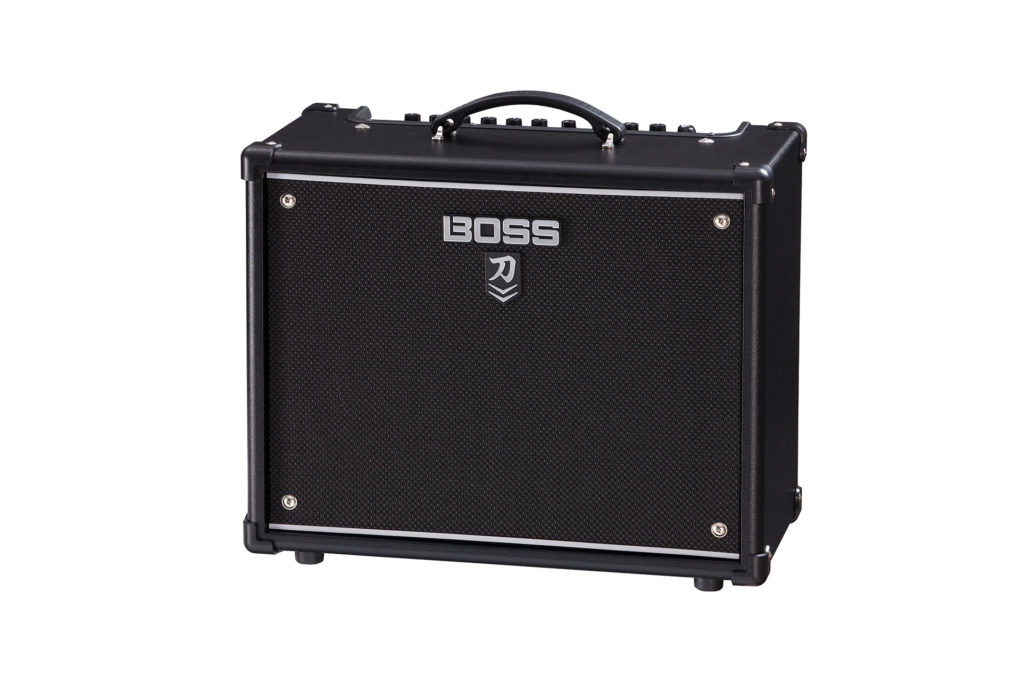
The Katana has a unique streamlined design. The looks of the amp are very minimal, which means you could easily walk past this in a music store – but it’s so popular that the chances of that happening are slim.
The cabinet is made of quality MDF wood. It’s very sturdy yet light. The main cab is covered in a plastic skin that’s reminiscent of Tolex, except it’s much harder and smoother.
The face of the amp is made of a rough, black cloth that will withstand some abuse. A metal ‘Boss’ logo is put at the top of the cloth, with the ‘Mark 2’ logo below it.
The knobs are situated at the top of the amp, slightly recessed into the cabinet. Most of the knobs are simple round knobs, and there’s one chicken-head style knob.
There’s also a handy carrying handle at the top of the amp. The handle is made of a sturdy rubber material.
Overall, not exactly overwhelming. Luckily, what’s important is how it operates and sounds…

One thing that’s often mentioned when speaking of the Katana is its wide range of features. The amp includes five amp models: Acoustic, clean, crunch, lead, and brown.
The amp also includes tons of effects ranging from chorus and flanger to auto-wah and harmonizers. All of the effects are emulated after official Boss pedals. Same with all the overdrives and distortions.
The knobs include an ‘amp type’ knob to switch between the five amp models. After comes a ‘gain’ and ‘volume’ knob. The volume knob is an independent volume control, so you can match volumes between your presets.
After that comes the equalization section which has the typical ‘bass’, ‘middle, and ‘treble’ knobs that you would expect. The eq has a great range, and is very responsive.
After that come the effects. There’s two buttons: ‘booster’ (overdrive/distortion) and ‘mod’ (modulation effects like chorus and flanger). The second set of buttons has an ‘FX’ and ‘delay’ section. These do exactly what they describe. The FX are effects, same with the mod knob. However, this includes more effects, like compressors and a second EQ section.
The last button in the effects section has the reverb tank. There are many different types of reverbs, like digital, analog, and modulating reverbs. All of these sound very nice and responsive.
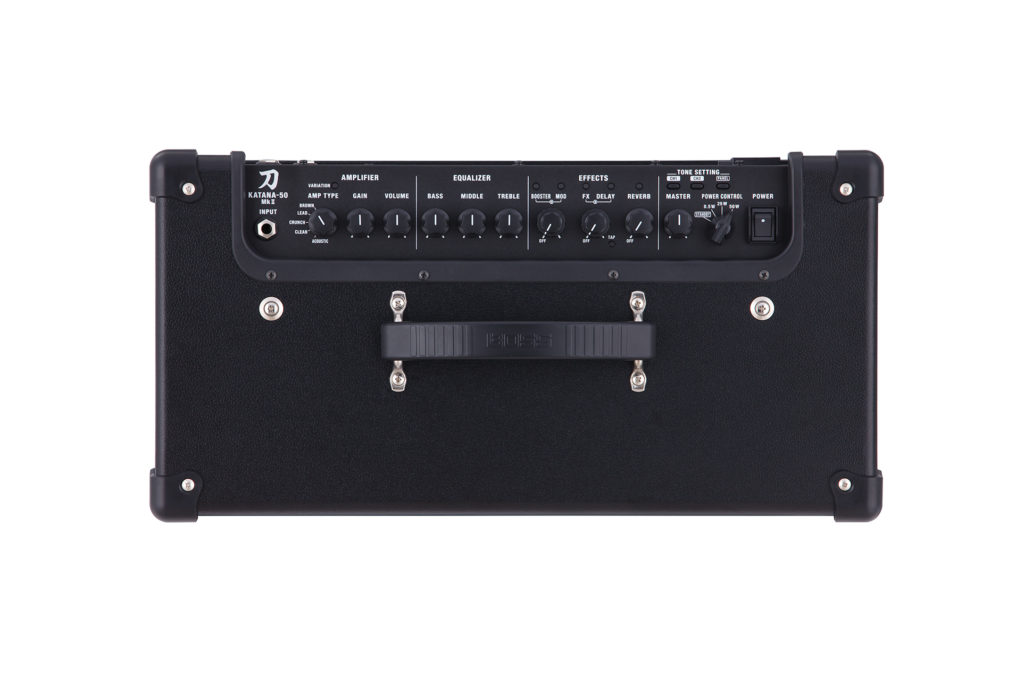
Above all the knobs are colored lights, which indicate what effect you’re on. You can set effects to certain colors in the Tone Studio software, so you can quickly switch effects right on the face of the amp. There’s also a tiny tap tempo button for the delay.
The next section has the presets, presence, master volume, cab resonance and power controls. The Katana 50 can save four presets plus a panel setting. All the other models include eight presets. The presets are divided over two banks.
The Katana 50 can switch from 0.5 watts, to 25 and 50 watts allowing you to play at any volume. All the other models have 100 watts, which can attenuate to 50 or 0.5 watts for lower volume.
Boss also provides their Tone Studio software which allows you to control every aspect of the amp and really start tweaking the tone. Here you can get crazy in detail with the effects. It includes easy to work with sliders to set every parameter. You can assign effects to the colors from here,
Also new in the MKII is the ‘power-amp in’ input on the back of the amp. This is meant for effects-processors and multi-effects units. With this, you can skip the preamp section and basically turn your Katana into a speaker for your effects processor.
Performance / Sound
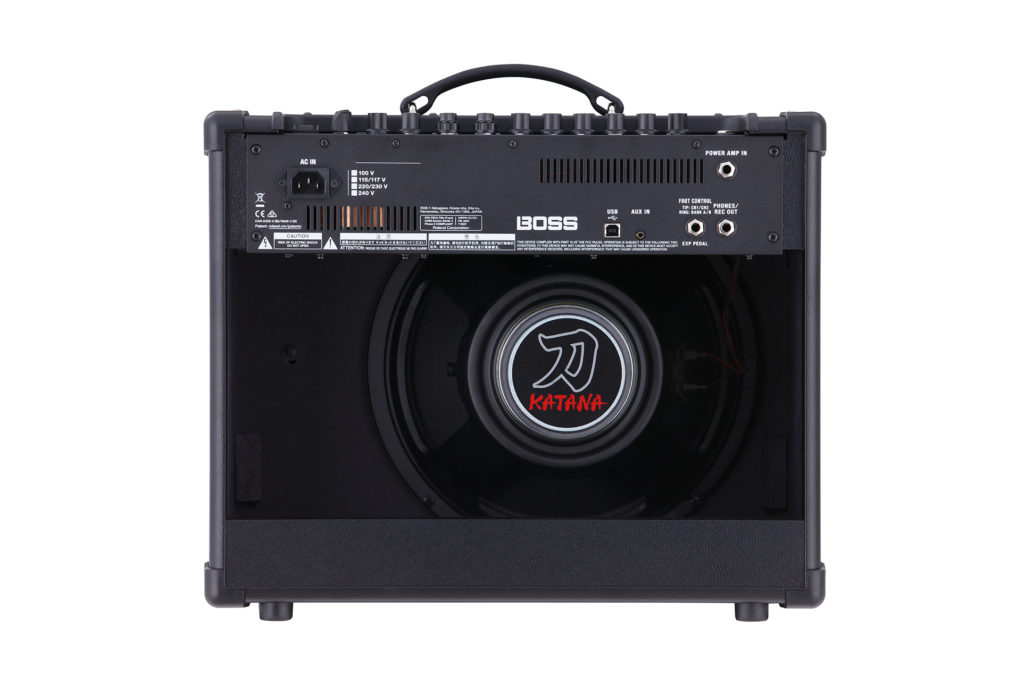
The ’acoustic’ channel is meant for acoustic guitar, and it’s kind of a blend between the clean channel and the direct sound of the guitar. Some people prefer using this channel for electric guitar with pedals, others say it kills the tone.
The ‘clean’ channel is exactly as advertised. It’s very clean at low gain, and nice and thick at higher gain. This channel can be used for everything from twangy country tones, to glass, funky John Frusciante tones. This channel also works very well with pedals, as does the ‘acoustic’ channel.
The ‘crunch’ channel is a little thinner sounding than the clean, and it’s the least good sounding channel in my opinion. This doesn’t mean it’s bad, but it’s not as impressive as the rest of the channels.
The ‘lead’ channel is basically the same as the crunch channel, except a little thicker and with much more gain. This channel is great for crunchy tones at low gain, and a true shredder at high gain.
The ‘brown’ channel is meant for the ’brown sound’, which is a very thick, high gain sound. This channel has a bit more gain than the lead channel, and it’s a bit boomier.
The effects are very good sounding. The analog effects sound very natural, and the digital effects are very good. The full list of effects is very long, and there’s variations between the same effects. As in, there’s a spring reverb, plate reverb, modulating reverb, plus digital chorus, keyboard chorus, multiple wahs, flangers, and any other effect you can ask for. The list is very extensive. Most of the effects are based on Boss’s own pedal, but there’s also pedals like the ProCo Rat, or the Ibanez TS9.
Clean, this amp sounds very warm. It sounds very close to a tube amp, especially on the clean channel. As I said, the EQ has incredible range, it can go from super boomy to incredibly tinny and everything in between just from the EQ controls.
The high-gain sounds are a little bit harder to tame though. For classic low-gain overdrive, I recommend not using the booster as it compresses and tightens the tone quite strong. The EQ is less important here.
For really high gain, using the booster is a must. It’s very hard to get a tight modern sound without using the booster. Luckily, the boosters are really good and easy to use. All booster pedals have a different character. The Blues Driver is pretty ballsy and gives tons of gain, whereas the Klon Centaur is a little bassier and more subtle, perfect for creamy lead tones.
The EQ is a little more important here, as it’s easy to get it to sound fizzy with too much of anything.
The Katana is very versatile, it can literally do anything. There’s even a whole database of user-made presets that emulate famous tones.
As for power, the Katana’s got plenty. It has a 50 watt solid-state poweramp, which doesn’t sound like much. But luckily, Boss counts the wattage compared to tube wattage, which means that the Katana 50 is as loud as class A/B 50-watt tube amp.
It’s really really loud. Personally, I’ve been able to easily get over a loud drummer and bass player with a 4×15 cab at not even half the total volume.
It sounds good at low volume as well. Even at the lowest possible setting on the 0.5 watt setting sounds pretty darn good. This amp is easily enough for playing at bars and even small/medium sized halls.
Even the direct-out sounds good. There’s a setting in the Tone Studio where you can set the ‘feel’ of the direct out. There’s ‘rec’, which has a built in cabinet simulator for recording. The cabinet sim is very good, but if you want to use your own, you can use the ‘live’ setting. There’s also a ‘blend,’ which is exactly what it says: a blend between the two.
For recording, you can plug the headphone out into your audio interface, or you can go direct with USB. Both sound very good, but if you use the USB, the signal will be very quiet, which can be a problem.
All in all, the Katana sounds very very good. This is the most important part of an amplifier, and Boss knocked it out of the park with this one.
There’s just one thing… Boss makes quite a few different variations of the Katana, and every one of them is a little different. It raises the question: “Which should I get?”.
Which one should you get?
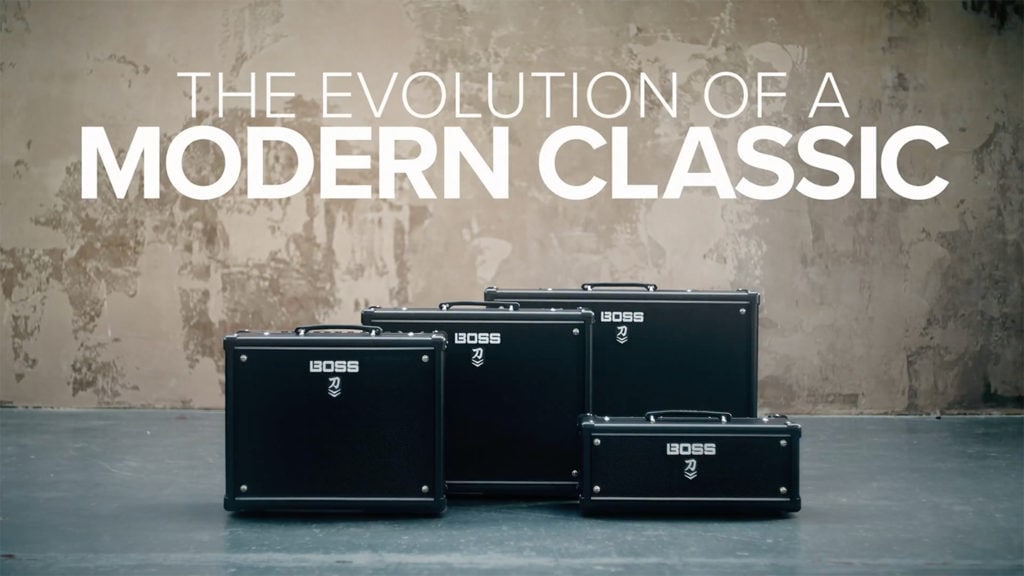
Boss currently makes five different models:
The Katana 50 is what we’ve been focusing on until now, but the other models are just as noteworthy.
The Katana 100 is basically the same as the 50, except it’s got a hundred watts instead of fifty, and it’s got an FX-loop. It also has four more channels spread over two banks.
The Katana 100/212 is the same as the 100, but it includes a second 12 inch speaker, as the name already suggests.
The Katana Artist is the flagship in the series. It’s got an improved 12 inch speaker, a hundred watts of power, and the buttons are on the front of the amp.
The Katana Head is the same as the 100, but in head form. This allows you to hook the Head to your preferred cabinet. This way you can get the Katana’s sound running through different speakers or more speakers at a time. The Head also includes a tiny speaker that can be used for practice, so you can leave your cab at the rehearsal space while still being able to practice at home, for instance.
This begs the question, which should you get? Luckily, I made a handy flowchart to answer this question:

Other Amps to Consider

Fender Mustang GTX100
Fender’s flagship modeling amp has been receiving positive reviews left and right. The pinnacle of Fender’s Mustang series has been reached at this workhorse of an amp. This amp has as many features as the Katana, except it can all be controlled through the LCD screen on the face of the amp.
This amplifier has tons of features and great tones, and all this clocks in at less than $500 in most places.

Blackstar ID:CORE 100
The classic brand Blackstar has made some of the most underrated amps in history, and their version of the modern modeling combo is one of them.
The ‘gimmick’ of the ID:CORE series is their stereo capability. Even the small ID:CORE 10 has two speakers to get those powerful stereo effects.
The ID:CORE 100 has three separate programmable channels running through two of Blackstar’s finest 10-inch speakers. The full power of this amp is hard to experience without trying it, and the stereo sounds really fill the room and suck you right in.
This amp is a very nice alternative to the Katana that comes in below $350 in most places.

Marshall Code 50
Even Marshall has been pumping out great modelling combos. The Code 50 is another great example of classic brands expanding their market. After the success of the MG series, it was time for Marshall to discover what they could get out of solid-state technology, and the answer was the Code series.
The Code series is supposed to model classic Marshall amps like the JTM, JVM, JCM800 and the Plexi Superlead. It does this surprisingly well, and it all sounds pretty great through the 12-inch speaker.
The Code also comes in a 100 watt head version, and Marshall even sells special Code 2×12 and 4×12 cabs designed specifically for the head.
Again, these amps are amazingly affordable. The Code 50 goes for around $250 in most places, and the head goes for around $300 new.
Final Thoughts on the Boss Katana 50 MKII
Some of the important bits:
- Great, great sound
- Easy to control panel
- Extensive preset library
- Different models to suit everyone
- Incredibly affordable
As with a lot of modern modeling amps, it’s easy to forget it’s so cheap. The Boss Katana 50 retails for around $250 new in most places, and around $150-200 used.
All in all, I don’t see anything bad about this combo. It’s affordable, it sounds good, and it’s got lots of features. Everytime someone asks me what the best affordable guitar amplifier is, I always respond with the Katana.
Check out these other articles you might like:

